Sustainable Green Roof Ecosystems: 100 Years of Functioning on Fortifications—A Case Study
Abstract
1. Introduction
- The characteristics of technogenic soils formed on the roofs of historical fortifications based on field studies;
- The present vegetation growing on shelter green roofs with some of the species’ ecological characteristics;
- Defined directions for the development, restoration, and protection of historic green roofs in the city peripheral areas in the context of the challenges posed by a changing climate.
1.1. Historical Green Roofs
1.2. How Green Roofs Function in an Urban Environment
1.3. Green Roofs on Shelters in Historical Guidelines
2. Materials and Methods
2.1. Study Sites
2.2. Analytical Methods
2.2.1. Historical Records
2.2.2. Soil Studies
2.2.3. Soil Water Storage
2.2.4. Floristic Studies
3. Results
3.1. Soil Studies
3.2. Soil Water Storage
3.3. Floristic Characterization of the Green Roofs with Reference to Habitat Conditions
4. Discussion and Data Limitations
5. Summary and Conclusions
- Green roofs created on fortifications in operation for over 100 years currently play an important role in city peripherals by improving storm water quality, reducing the rate and volume of runoff, mitigating the urban island heat effect, and supporting wildlife and habitat biodiversity, as well as carbon sequestration, and providing urban dwellers with the educational benefits of small-scale ecosystems. As “wild green roofs” on ageing shelters, they constitute a place of refuge for native forest plant species and for species biodiversity and are a valuable element of the system of ecological panels and corridors.
- In order to preserve their natural values, one should limit anthropopression, which is understood as actions aimed at transforming these sustainable ecosystems.
- Protective measures should be taken to care for the vegetation and soil environment of green roofs, especially the surface horizon of the soil in which the accumulation of organic matter occurs alongside the accumulation of nutrients for plants and water retention.
- The protective measures should especially include:
- -
- Keeping the roof area off limits (to pedestrian traffic) as far as possible, as it was during the military use of the buildings, in order to prevent damage to the soil litter;
- -
- Preservation of the herb and shrub layer containing, inter alia, juvenile tree stages, which enables natural renewal of the tree stand;
- -
- Care must be taken to protect soil organisms responsible for the breakdown of organic matter, eliminating invasive species, especially Padus serotina and monitoring their settlement on green roofs;
- -
- When repairing and maintaining flat roofs, the original soil should be re-used, avoiding fertilization and the introduction of new species, especially ornamental plants. This would favor the preservation of genius loci, combining historical, cultural, and natural values, constituting an interesting complement to the “blue-green infrastructure” of the city.
Author Contributions
Funding
Acknowledgments
Conflicts of Interest
References
- Sukopp, H. Human-caused impact on preserved vegetation. Landsc. Urban Plan. 2004, 68, 347–355. [Google Scholar] [CrossRef]
- Hüttl, R.E.; David, K.; Schneider, B.U. Historic gardens and climate change. In sights, Desiderata and Recommendations. In Historische Gärten und Klimawandel. Eine Aufgabe Für Gartendenkmalpflege, Wissenschaft und Gesellschaft; De Gruyter: Berlin, Germany, 2019; p. 423. [Google Scholar]
- Megarry, W. Future of Our Pasts: Engaging Cultural Heritage in Climate Action: Report of the ICOMOS Workings Group on Climate Change and Cultural Heritage; International Council on Monuments and Sites: Paris, France, 2019. [Google Scholar]
- United Nations. Recommendation on the Historic Urban Landscape; United Nations: Paris, France, 2011. [Google Scholar]
- United Nations. Transforming Our World: The 2030 Agenda for Sustainable Development; United Nations: New York, NY, USA, 2015; Available online: https://sustainabledevelopment.un.org/post2015/transformingourworld (accessed on 10 March 2020).
- Fluck, H.; Wiggins, M. Climate change, heritage policy and practice in England: Risks and opportunities. Archaeol. Rev. Camb. 2017, 32, 159–181. [Google Scholar] [CrossRef]
- Pardela, Ł.; Wilkaniec, A.; Środulska-Wielgus, J.; Wielgus, K. Znaczenie terenów zieleni pofortecznej dla zieleni miejskiej Krakowa, Poznania i Wrocławia. Nauka Przyr. Technol. 2018, 12, 153–162. [Google Scholar] [CrossRef][Green Version]
- Pardela, Ł.; Kolouszek, S. Twierdza Wrocław 1890–1918. Monografia, 1st ed.; Via Nova: Wrocław, Poland, 2017; ISBN 978-83-64025-35-8. [Google Scholar]
- Pawlas, K.; Rabczenko, D.; Krzeszofiak, J. Ocena Wpływu Pyłowych Zanieczyszczeń Powietrza Na Zapadalność Na Wybrane Schorzenia, Dla Obszaru Miasta Wrocławia, Uniwersytet Wrocławski: Wrocław, Poland, 2018. Available online: http://life-apis.meteo.uni.wroc.pl/images/Raport_meteo.pdf (accessed on 10 March 2020).
- Hogg, I. The History of Fortification; St. Martin’s Press Inc.: New York, NY, USA, 1981. [Google Scholar]
- Johnston, J.; Newton, J. Building Green. A guide to Using Plants on Roofs, Walls and Pavements; Greater London Authority: London, UK, 2004. [Google Scholar]
- Köhler, M.; Michael, C.A. Green Roof Infrastructures in Urban Areas. In Sustainable Built Environments; Springer: New York, NY, USA, 2012; pp. 4698–4705. ISBN 978-1-4614-5828-9. [Google Scholar]
- Catalano, C.; Marcenò, C.; Laudicina, V.A.; Guarino, R. Thirty years unmanaged green roofs: Ecological research and design implications. Landsc. Urban Plan. 2016, 149, 11–19. [Google Scholar] [CrossRef]
- Thuring, C.E.; Dunnet, N.P. Persistence, loss and gain: Characterising mature green roof vegetation by functional composition. Landsc. Urban Plan. 2019, 185, 228–236. [Google Scholar] [CrossRef]
- Köhler, M. Long-Term Vegetation Research on Two Extensive Green Roofs in Berlin. Urban Habitats 2006, 4, 3–26. [Google Scholar]
- Thuring, C.E.; Dunnet, N.P. Vegetation composition of old extensive green roofs (from 1980s Germany). Ecol. Process. 2014, 3. [Google Scholar] [CrossRef]
- Köhler, M.; Kaiser, D. Evidence of the climate mitigation effect of green roofs—A 20-year weather study on an extensive green roof (EGR) in Northeast Germany. Buildings 2019, 9, 157. [Google Scholar] [CrossRef]
- Ahrendt, J. Historische Grundacher: Ihr Entwicklungsgang bis zur Erfindung des Eisenbetons. Ph.D. Thesis, Technischen Universität Berlin, Berlin, Germany, 2007. [Google Scholar]
- Besir, A.B.; Cuce, E. Green roofs and facades: A comprehensive review. Renew. Sustain. Energy Rev. 2018, 915–939. [Google Scholar] [CrossRef]
- Jim, C.Y. An archaeological and historical exploration of the origins of green roofs. Urban For. Urban Green. 2017, 27, 32–42. [Google Scholar] [CrossRef]
- Speak, A.F.; Rothwell, J.J.; Sidley, S.J.; Smith, C.L. Rainwater runoff retention on an aged intensive green roof. Sci. Total Environ. 2013, 461–462, 28–38. [Google Scholar] [CrossRef]
- Kreh, W. Beiträge zur Vegetationskunde von Württemberg. Jahresh. Des Ver. Für Vaterländische Nat. Württemberg 1945, 97–101, 199–219. [Google Scholar]
- Bornkamm, R. Vegetation und vegetations-entwicklung auf kiesdächern. Vegetatio 1961, 10, 1–24. [Google Scholar] [CrossRef]
- Ksiazek-Mikenas, K.; Köhler, M. Traits for stress-tolerance are associated with long-term plant survival on green roofs. J. Urban Ecol. 2018, 1–10. [Google Scholar] [CrossRef]
- Magill, J.D.; Midden, K.; Groningen, J.; Therrell, M. A History and Definition of Green Roof Technology with Recommendations for Future Research. Master’s Thesis, Southern Illinois University, Carbondale, IL, USA, 2011. [Google Scholar]
- Shafique, M.; Kim, R.; Rafiq, M. Green roof benefits, opportunities and challenges—A review. Renew. Sustain. Energy Rev. 2018, 90, 757–773. [Google Scholar] [CrossRef]
- Rowe, B.D. Long-term Rooftop Plant Communities. In Green Roof Ecosystems; Ecological Studies 223; Springer: Cham, Switzerland, 2015; pp. 311–332. ISBN 978-3-319-14982-0. [Google Scholar]
- Brenneisen, S. Space for urban wildlife: Designing green roofs as habitats in Switzerland. Urban Habitats 2006, 4, 27–36. [Google Scholar]
- Landlot, E. Orchideen-Wiesen in Wollishofen (Zürich)-ein erstaunliches Relikt aus der Anfang des 20. Jahrhunderts. Vierteljahrsschr. Nat. Ges. Zürich 2001, 146, 41–51. [Google Scholar]
- Jankowski, M.; Bednarek, R.; Jaworska, M. Soils constructed on the 19th century fortifications in Toruń. In Technogenic Soils of Poland; Polish Society of Soil Science: Toruń, Poland, 2013; pp. 345–357. ISBN 978-83-934096-1-7. [Google Scholar]
- Pardela, Ł.; Kowalczyk, T. Estimated soil water storage within a historical bunker during the growth period of vegetation. J. Water Land Dev. 2018, 125–130. [Google Scholar] [CrossRef]
- Coutts, C.; Hahn, M. Green infrastructure, ecosystem services, and human health. Int. J. Environ. Res. Public Health 2015, 12, 9768–9798. [Google Scholar] [CrossRef]
- Oberndorfer, E.; Lundholm, J.; Brass, B.; Coffman, R.R.; Doshi, H.; Dunnet, N.P.; Graffin, S.; Köhler, M.; Liu, K.K.Y.; Rowe, B. Green roofs as urban ecosystems: Ecological structures, functions, and services. BioScience 2007, 57, 823–833. [Google Scholar] [CrossRef]
- Van Renterghem, T. Green roofs for acoustic insulation and noise reduction. In Nature Based Strategies for Urban and Building Sustainability; Elsevier: New York, NY, USA, 2018; pp. 167–178. ISBN 879-0-12-812150-4. [Google Scholar]
- Whittinghill, L.J.; Rowe, B.D.; Schutzki, R.; Cregg, B.M. Quantifying carbon sequestration of various green roof and ornamental landscape systems. Landsc. Urban Plan. 2014, 41–48. [Google Scholar] [CrossRef]
- Grard, B.J.P.; Chenu, C.; Manouchehri, N.; Houot, S.; Frascaria-Lacoste, N.; Aubry, C. Rooftop farming on urban waste provides many ecosystem services. Agron. Sustain. Dev. 2018, 38. [Google Scholar] [CrossRef]
- Lundholm, J. Plant effects on green roof ecosystem services: A 10-year retrospective. In Proceedings of the Cities Alive: 13th Annual Green Roof and Wall Conference, New York, NY, USA, 5–8 October 2015; pp. 1–15. [Google Scholar] [CrossRef]
- Maclvor, J.S. Building height matters: Nesting activity of bees and wasps on vegetated roofs. Isr. J. Ecol. Evol. 2016, 62, 88–96. [Google Scholar] [CrossRef]
- Fernandez-Canero, R.; Gonzales-Redondo, P. Green roofs as a habitat for birds: A review. J. Anim. Vet. Adv. 2010, 9, 2041–2052. [Google Scholar] [CrossRef]
- General Inspection of the Engineer and Pioneer Corps and of Fortresses. Erdbau in Permanenten Landbefestigungen; Reichsdruckerei: Berlin, Germany, 1889. [Google Scholar]
- General Inspection of the Engineer and Pioneer Corps and of Fortresses. Mauerbau; Reichsdruckerei: Berlin, Germany, 1898. [Google Scholar]
- General Inspection of the Engineer and Pioneer Corps and of Fortresses. Maßnahmen Gegen die Erkennbarkeit von Befestigungsanlagen (Schutzmaßnahmen); Reichsdruckerei: Berlin, Germany, 1905. [Google Scholar]
- Rolf, R. Die Entwicklung des Deutschen Festungssystems seit 1870—Vollständige und Bearbeitete Ausgabe des Manuskriptes, 1st ed.; Fortress Books: Tweede Exloërmond, The Netherlands, 2000; ISBN 90-76396-08-6. [Google Scholar]
- Rolf, R. Armour Forts and Trench Shelters. German Imperial Fortifications 1870–1918, 1st ed.; PRAK Publishing: Middelburg, The Netherlands, 2017; ISBN 978-90-817095-3-8. [Google Scholar]
- United Nations. World Reference Base for Soil Resources 2014. International Soil Classification System for Naming Soils and Creating Legends for Soil Maps; World Soil Resources Reports 106; United Nations: Rome, Italy, 2014; ISBN 978-92-5-108369-7. [Google Scholar]
- Topp, G.C.; Zebchuk, W. The determination of soil-water desorption curves for soil cores. Can. J. Soil Sci. 1979, 19–26. [Google Scholar] [CrossRef]
- Klute, A. Water Retention: Laboratory Methods. In Methods of Soil Analysis: Part 1—Physical and Mineralogical Methods; Agricultural Research Service and USDA: Fort Collins, CO, USA, 1986; pp. 635–662. ISBN 978-0-89118-864-3. [Google Scholar]
- PN-R-04032:1998 Standard. Soil and Mineral Materials—Sampling and Determination of Particle Size Distribution; The Polish Committee for Standardization: Warsaw, Poland, 1998; ISBN 83-236-1077-0.
- Polskie Towarzystwo Gleboznawcze. Klasyfikacja Uziarnienia Gleb i Utworów Mineralnych PTG; Polskie Towarzystwo Gleboznawcze: Warsaw, Poland, 2008. [Google Scholar]
- Soil Survey Staff Keys to Soil Taxonomy, 12th ed.; USDA-Natural Resources Conservation Service: Washington, DC, USA, 2014.
- Kabała, C. Polish Soil Classification, 6th edition-principles, classification scheme and correlations. Soil Sci. Annu. 2019, 70, 71–97. [Google Scholar] [CrossRef]
- Mirek, Z.; Piękoś-Mirkowa, H.; Zając, M. Flowering Plants and Pteridophytes of Poland. A Checklist; Biodiversity of Poland; Polish Academy of Sciences: Kraków, Poland, 2002; ISBN 83-85444-83-1. [Google Scholar]
- Zarzycki, K.; Trzcińska-Tacik, H.; Różański, W.; Szelong, Z.; Wołek, J.; Korzeniak, U. Ecological Indocator Values of Vascular Plants of Poland; Biodiversity of Poland; Polish Academy of Sciences: Kraków, Poland, 2002; ISBN 83-85444-95-5. [Google Scholar]
- Baryła, A.; Karczmarczyk, A.; Bys, A. Role of Substrates Used for Green Roofs in Limiting Rainwater Runoff. J. Ecol. Eng. 2018, 19, 86–92. [Google Scholar] [CrossRef]
- Berndtsson, J.C. Green roof performance towards management of runoff water quantity and quality: A review. Ecol. Eng. 2010, 36, 351–360. [Google Scholar] [CrossRef]
- Stovin, V.; Vesuviano, G.; De-Ville, S. Defining green roof detention performance. Urban Water J. 2017, 14, 574–588. [Google Scholar] [CrossRef]
- Pęczkowski, G.; Kowalczyk, T.; Szawernoga, K.; Orzepowski, W.; Żmuda, R.; Pokładek, R. Hydrological Performance and Runoff Water Quality of Experimental Green Roofs. Water 2018, 10, 1185. [Google Scholar] [CrossRef]
- Bengtsson, L.; Grahn, L.; Olsson, J. Hydrological function of a thin extensive green roof in southern Sweden. Hydrol. Res. 2005, 36, 259–268. [Google Scholar] [CrossRef]
- Dunnet, N.P.; Kingsbury, N. Planting Green Roofs and Living Walls, 1st ed.; Timber Press: Portland, ME, USA, 2004; ISBN 978-0-88192-640-8. [Google Scholar]
- Liu, W.; Feng, Q.; Chen, W.; Wei, W.; Deo, R.C. The influence of structural factors on stormwater runoff retention of extensive green roofs: New evidence from scale-based models and real experiments. J. Hydrol. 2019, 230–238. [Google Scholar] [CrossRef]
- Carter, T.; Rasmussen, T.C. Hydrologic behavior of vegetated roofs. J. Am. Water Resour. Assoc. 2006, 42, 1261–1274. [Google Scholar] [CrossRef]
- Simmons, M.T.; Gardiner, B.; Windhager, S.; Tinsley, J. Green Roofs are Not Created Equal: The Hydrologic and Thermal Performance of Six Different Extensive Green Roofs and Reflective and Non-reflective Roofs in a Sub-tropical Climate. Urban Ecosyst. 2008, 339–348. [Google Scholar] [CrossRef]
- Zubelzu, S.; Rodriquez-Sinobas, L.; Andrés-Domenech, I.; Castillo-Rodriguez, J.T.; Perales-Momparler, S. Design of water reuse storage facilities in Sustainable Urban Drainage Systems from a volumetric water balance perspective. Sci. Total Environ. 2019, 133–143. [Google Scholar] [CrossRef]
- Mentens, J.; Raes, D.; Hermy, M. Green roofs as a tool for solving the rainwater runoff problem in the urbanized 21st century? Landsc. Urban Plan. 2006, 77, 217–226. [Google Scholar] [CrossRef]
- Villarreal, E.L.; Bengtsson, L. Response of a Sedum green-roof to individual rain events. Ecol. Eng. 2005, 25, 1–7. [Google Scholar] [CrossRef]
- Getter, K.G.; Rowe, B.D.; Andresen, J.A. Quantifying the effect of slope on extensive green roof stormwater retention. Ecol. Eng. 2007, 31, 225–231. [Google Scholar] [CrossRef]
- Zhang, S.; Guo, Y. Analytical Probabilistic Model for Evaluating the Hydrologic Performance of Green Roofs. J. Hydrol. Eng. 2013, 18, 19–28. [Google Scholar] [CrossRef]
- Fassman-Beck, E.; Voyde, E.; Simcock, R.; Sing Hong, Y. 4 Living roofs in 3 locations: Does configuration affect runoff mitigation? J. Hydrol. 2013, 11–20. [Google Scholar] [CrossRef]
- Hathaway, A.M.; Hunt, W.F.; Jennings, G.D. A field study of green roof hydrologic and water quality performance. Trans. Am. Soc. Agric. Biol. Eng. 2008, 51, 37–44. [Google Scholar]
- Van Seters, T.; Rocha, L.; MacMillan, G. Evaluation of Green Roofs for Runoff Retention, Runoff Quality, and Leachability. Water Qual. Res. J. Can. 2009, 44, 33–47. [Google Scholar] [CrossRef]
- Palla, A.; Sansalone, J.J.; Lanza, L.G. Storm water infiltration in a monitored green roof for hydrologic restoration. Water Sci. Technol. 2011, 64, 766–773. [Google Scholar] [CrossRef]
- Graceson, A.; Hare, M.; Monaghan, J.; Hall, N. The water retention capabilities of growing media for green roofs. Ecol. Eng. 2013, 328–334. [Google Scholar] [CrossRef]
- Wong, G.K.L.; Jim, C.Y. Identifying keystone meteorological factors of green-roof stormwater retention to inform design and planning. Landsc. Urban Plan. 2015, 173–182. [Google Scholar] [CrossRef]
- Cipolla, S.S.; Maglionico, M.; Stojkov, I. A long-term hydrological modelling of an extensive green roof by means of SWMM. Ecol. Eng. 2016, 876–887. [Google Scholar] [CrossRef]
- Szota, C.; Farrell, C.; Williams, N.G.S.; Arndt, S.K.; Fletcher, T.D. Drought-avoiding plants with low water use can achieve high rainfall retention without jeopardising survival on green roofs. Sci. Total Environ. 2017, 603, 340–351. [Google Scholar] [CrossRef]
- Stovin, V.; Vesuviano, G.; Kasmin, H. The hydrological performance of a green roof test bed under UK climatic conditions. J. Hydrol. 2012, 148–161. [Google Scholar] [CrossRef]
- Liesecke, H.J. Extensive begrunung bei 5° dachneigung. Stadt Grün 1999, 48, 337–346. [Google Scholar]
- Scholz-Barth, K. Green Roofs: Stormwater Management from the Top Down. Environ. Des. Constr. 2001, 4, 63–69. [Google Scholar]
- Voyde, E.; Fassman, E.; Simcock, R. Hydrology of an extensive living roof under sub-tropical climate conditions in Auckland, New Zealand. J. Hydrol. 2010, 394, 384–395. [Google Scholar] [CrossRef]
- Fassman, E.; Simcock, R.; Voyde, E. Extensive Green (Living) Roofs for Stormwater Mitigation. Part 1: Design and Construction; Auckland Regional Council: Auckland, New Zeland, 2010; p. 184. [Google Scholar]
- Hilten, R.N.; Lawrence, T.M.; Tollner, E.W. Modeling stormwater runoff from green roofs with HYDRUS-1D. J. Hydrol. 2008, 358, 288–293. [Google Scholar] [CrossRef]
- Nardini, A.; Andri, S.; Crasso, M. Influence of substrate depth and vegetation type on temperature and water runoff mitigation by extensive green roofs: Shrubs versus herbaceous plants. Urban Ecosyst. 2012, 697–708. [Google Scholar] [CrossRef]
- Metselaar, K. Water retention and evapotranspiration of green roofs and possible natural vegetation types. Resour. Conserv. Recycl. 2012, 49–55. [Google Scholar] [CrossRef]
- Best, B.B.; Swadek, R.K.; Burgess, T.I. Soil-Based Green Roofs. In Green Roof Ecosystems; Ecological Studies 223; Springer: Cham, Switzerland, 2015; pp. 139–174. ISBN 978-3-319-14983-7. [Google Scholar]
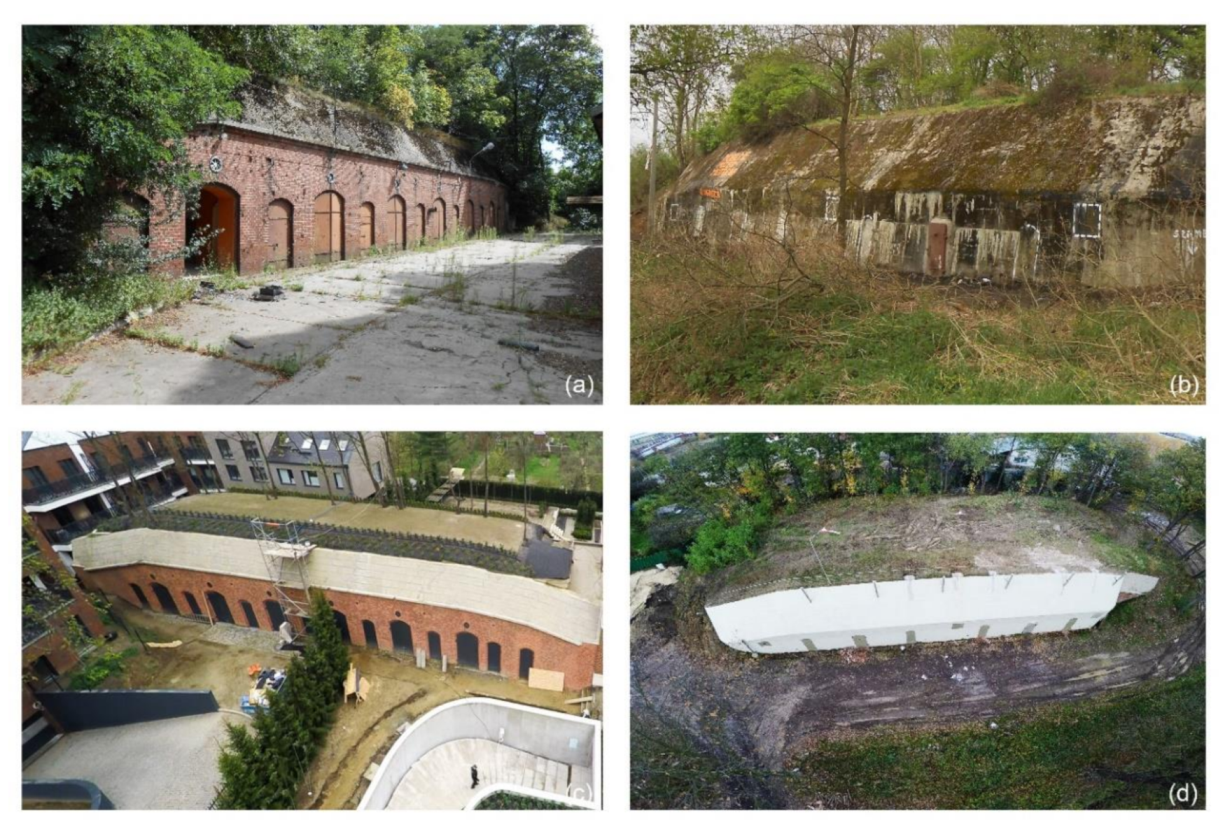
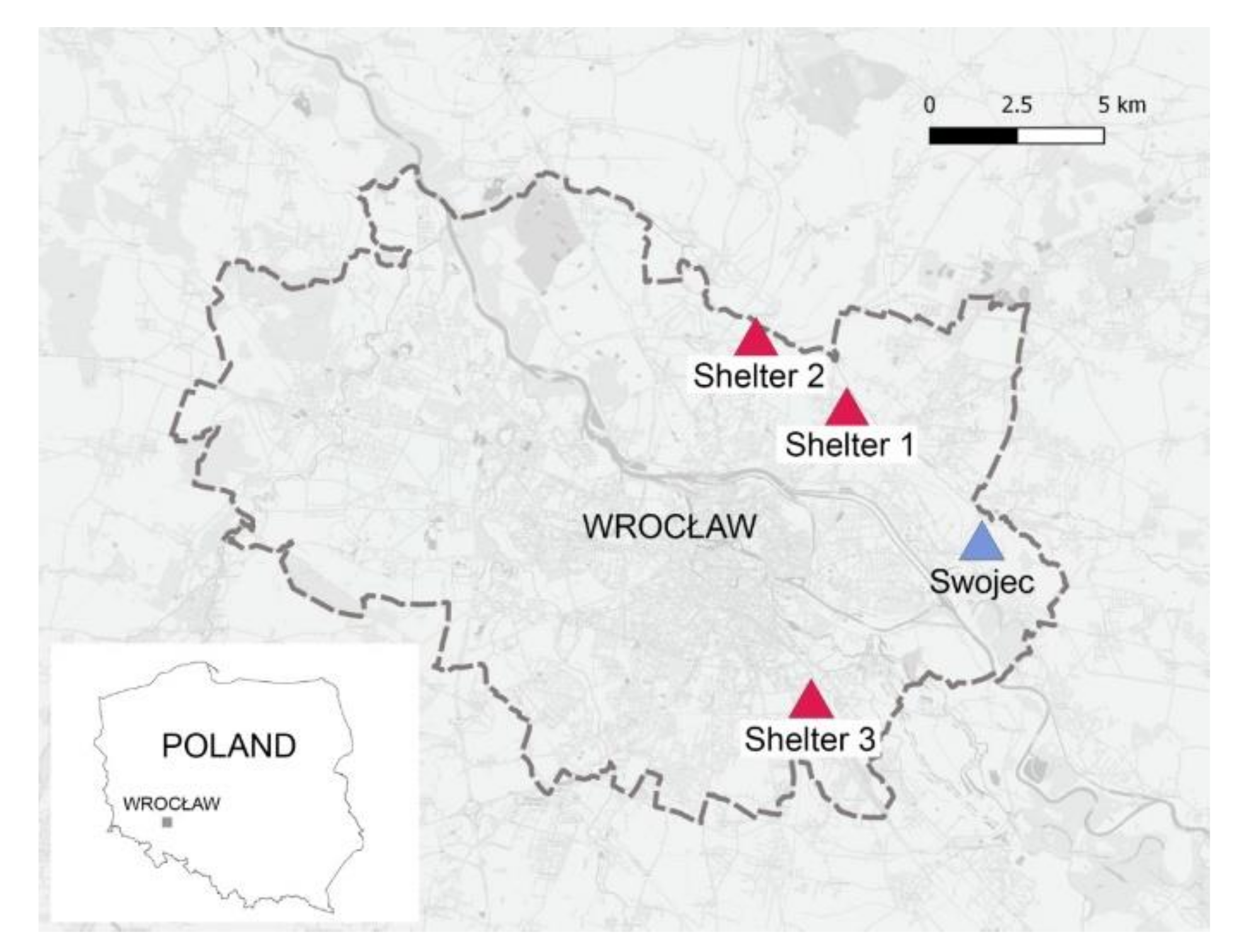
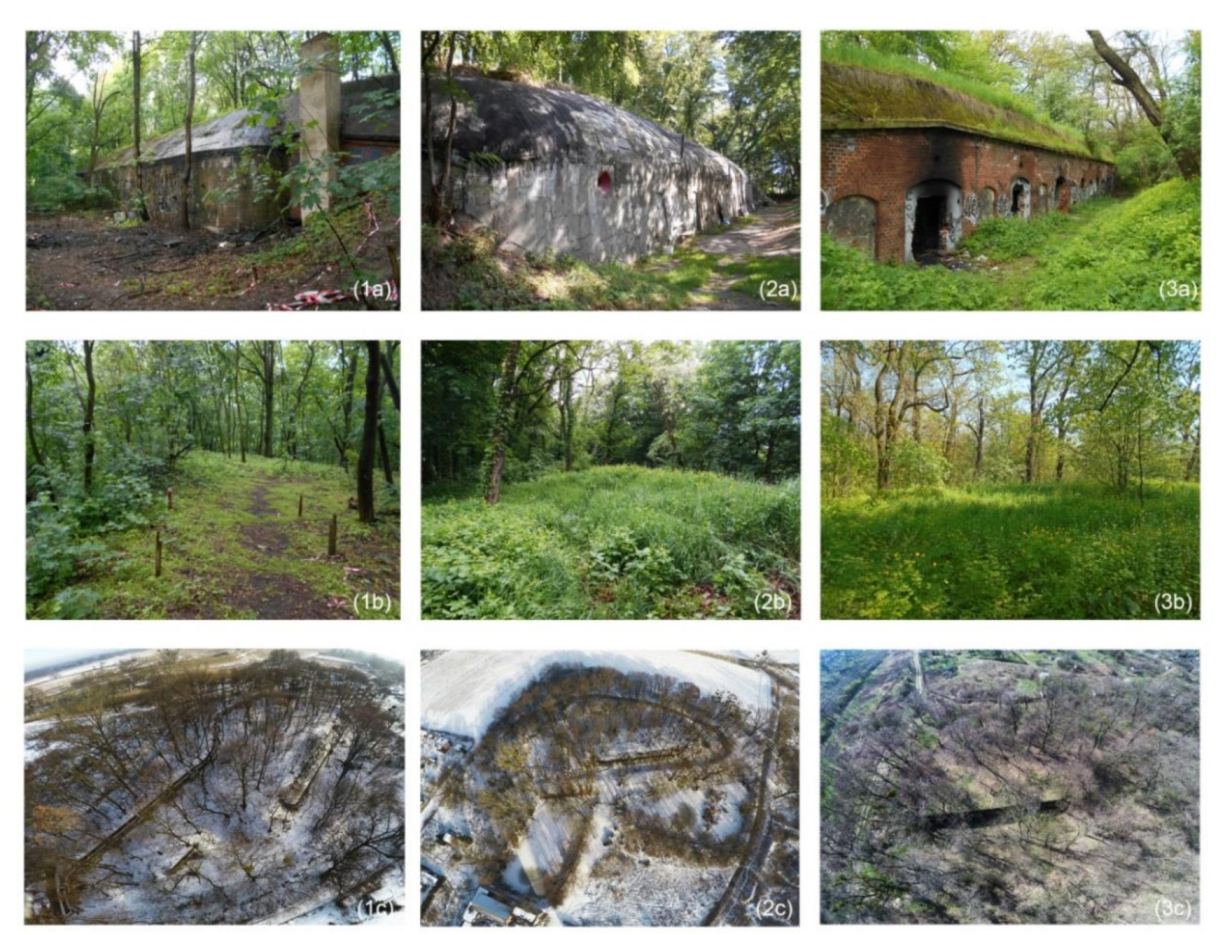
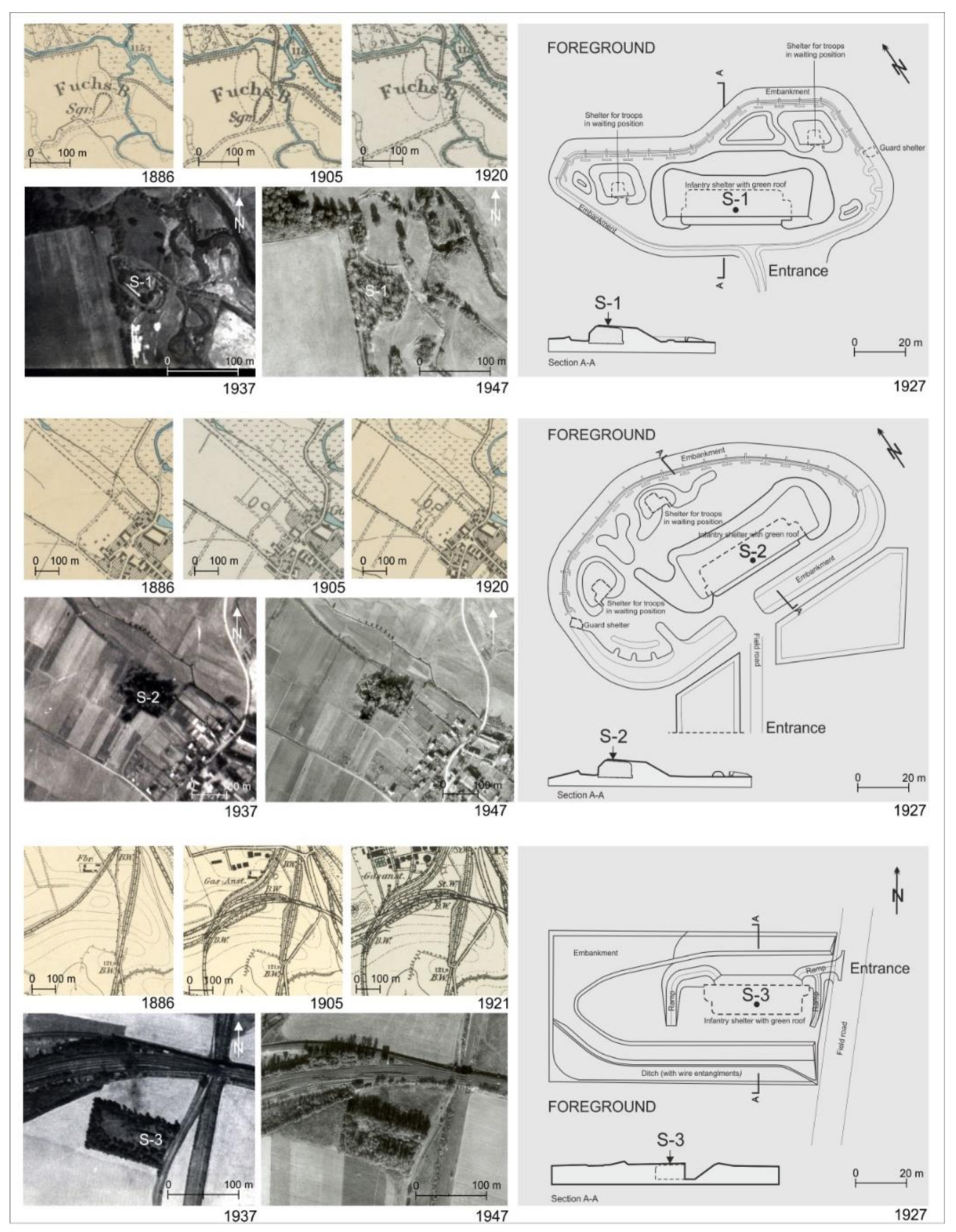

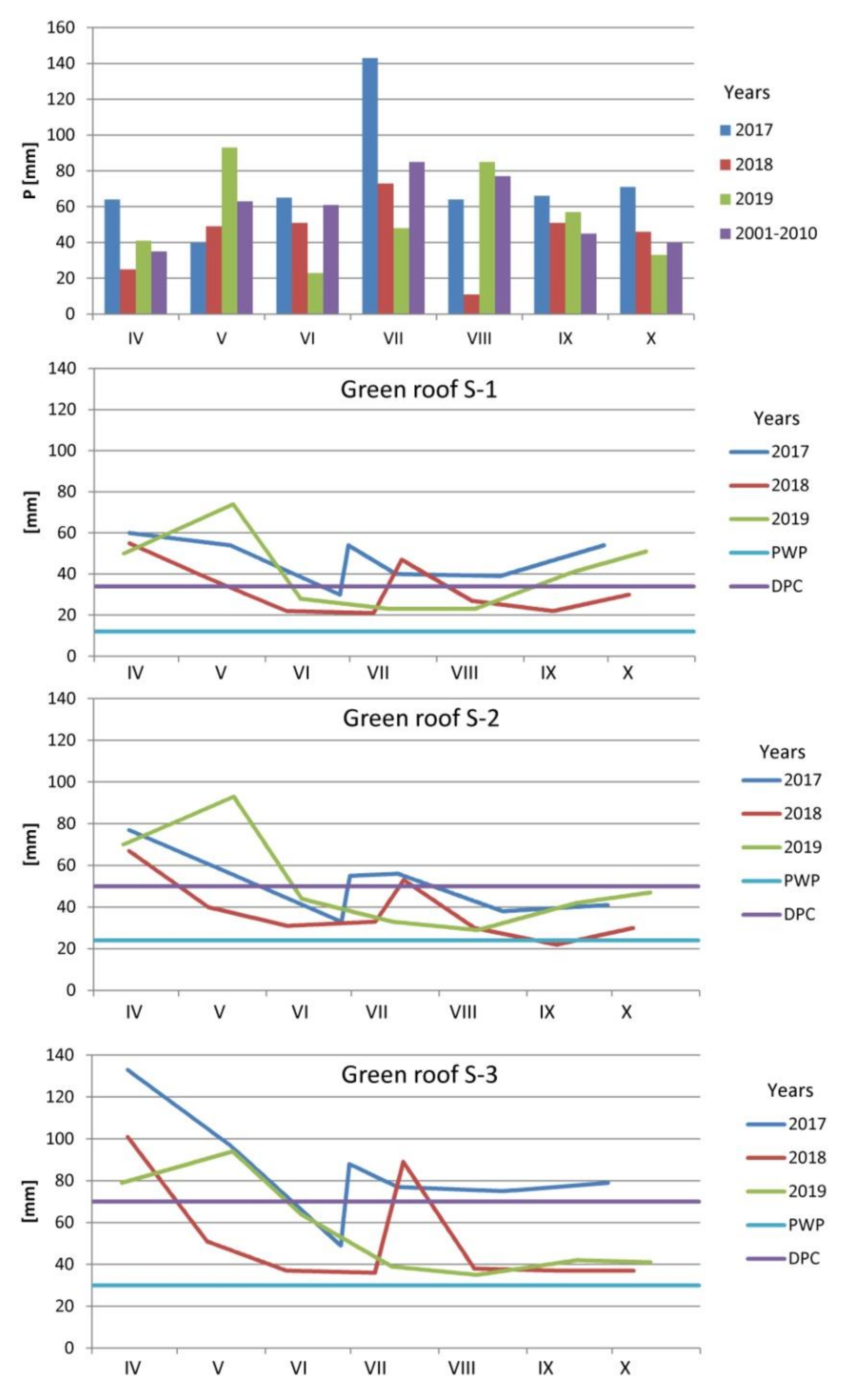
| Study Site | Location | Historical Name | Year Installed | Approx. Size (m2) | Age (when Surveyed) |
|---|---|---|---|---|---|
| Shelter S-1 | 51°9′1.934” N 17°5′13.829” E | Infanterie Stützpunkt 4 | 1891 | 488 | 128 |
| Shelter S-2 | 51°9′53.118” N 17°2′37.137” E | Infanterie Stützpunkt 6 | 1891 | 488 | 128 |
| Shelter S-3 | 51°4′26.654” N 17°4′23.994” E | Infanterie Raum 20 | 1900 | 420 | 119 |
| Years | P (mm) | |||
|---|---|---|---|---|
| XI‒X | XI‒IV | V‒X | IV‒IX | |
| 2017 | 668 | 219 | 449 | 442 |
| 2018 | 415 | 134 | 281 | 260 |
| 2019 | 535 | 196 | 339 | 347 |
| 2001–2010 | 587 | 216 | 371 | 366 |
| Years | T (°C) | |||
|---|---|---|---|---|
| XI‒X | XI‒IV | V‒X | IV‒IX | |
| 2017 | 9.7 | 3.0 | 16.3 | 15.8 |
| 2018 | 10.8 | 4.0 | 17.6 | 18.1 |
| 2019 | 10.5 | 4.4 | 16.7 | 16.5 |
| 2001–2010 | 9.5 | 3.3 | 15.8 | 15.9 |
| Species | Shelter | Ecological Indicator | |||||
|---|---|---|---|---|---|---|---|
| 1 | 2 | 3 | W | Tr | R | L | |
| Tree layer | |||||||
| Populus alba L. dead | + | 3‒4 | 4 | 5 | 4 | ||
| Quercus robur L. | + | + | + | 3‒4 | 3‒4 | 3‒4 | 4 |
| Robinia pseudoacacia L. | 1 | 3 | 2 | 2‒3 | 3 | 3‒5 | 4 |
| Acer platanoides L. | 3 | 3 | 2 | 3 | 3‒4 | 4 | 4 |
| Acer pseudoplatanus L. | 2 | 3/4 | 4 | 3‒5 | 3 | ||
| Tilia cordata Miller | 1 | 3 | 4‒3 | 4‒3 | 3 | ||
| Tilia platyphyllos Scop. | + | 3 | 4 | 5‒4 | 3 | ||
| Shrub layer | |||||||
| Populus tremula L. juveniles | + | + | 3 | 3 | 3 | 3 | |
| Quercus robur L. juveniles | 1 | 3‒4 | 3‒4 | 3‒4 | 4 | ||
| Ulmus minor Miller juveniles | + | 1 | 2‒4 | 4 | 4 | 3 | |
| Crategus laevigata (Poir.) DC. | 1 | 2 | 3‒4 | 3‒5 | 4‒5 | 4‒5 | |
| Crategus monogyna Jacq. | + | 3‒4 | 3‒5 | 3‒5 | 3‒5 | ||
| Padus avium Mill. | 2 | 4 | 4 | 4‒5 | 3 | ||
| Padus serotina (Ehrh.) J.Agardh juveniles | 1 | 2 | 1 | 3 | 3 | 3‒4 | 3‒4 |
| Rosa canina L. dead | + | 3‒4 | 3‒5 | 3‒4 | 4‒5 | ||
| Rubus plicatus W. et N. | 2 | 2 | 3‒4 | 3 | 2‒4 | 4‒5 | |
| Robinia pseudoacacia L. juveniles | 1 | 2‒3 | 3 | 3‒5 | 4 | ||
| Acer platanoides L. juveniles | + | + | + | 3 | 3‒4 | 4 | 4 |
| Acer pseudoplatanus L. juveniles | 1 | 3/4 | 4 | 3‒5 | 3 | ||
| Cornus mas L. | 1 | * | * | * | * | ||
| Syringa vulgaris L. | + | * | * | * | * | ||
| Sambucus nigra L. | 2 | 1 | 3‒4 | 4‒5 | 4 | (5)4‒3 | |
| Sympharicarpos albus (L.) Blake | + | * | * | * | * | ||
| Liana | |||||||
| Humulus lupulus L. | + | 4‒5 | 4‒5 | 4‒5 | 3 | ||
| Parthenocissus quinquaefolia (L.) Planchon | + | 2 | * | * | * | * | |
| Herb layer under the tree canopy | |||||||
| Quercus robur L. seedings | 3 | 2 | 3‒4 | 3‒4 | 3‒4 | 4 | |
| Ulmus minor Miller seedlings | 1 | 2‒4 | 4 | 4 | 3 | ||
| Chelidonium majus L. | 2 | 1 | 1 | 3 | 4‒5 | 4‒5 | 3‒4 |
| Alliaria petiolata (Bieb.) Cav. et Grande | 1 | 1 | 1 | 3/4 | 5 | 4 | 3 |
| Crataegus monogyna Jacq seedlings | 1 | 3‒4 | 3‒5 | 3‒5 | 3‒5 | ||
| Geum urbanum l. | 2 | 3‒4 | 3‒4 | 4‒5 | 2‒3 | ||
| Padus serotina (Ehrh.) J. Agardh seedlings | 1 | 2 | 3 | 3 | 3‒4 | 3‒4 | |
| Robinia pseudoacacia L. seedlings | 2 | 2 | 2‒3 | 3 | 3‒5 | 4 | |
| Acer platanoides L. seedlings | 3 | 2 | 1 | 3 | 3‒4 | 4 | 4 |
| Acer pseudoplatanus L. seedlings | 1 | 3/4 | 4 | 3‒5 | 3 | ||
| Impatiens noli-tangere L. | 1 | 4 | 4 | 4‒5 | 2‒3 | ||
| Impatiens parviflora DC. | 2 | 2 | 1 | 3 | 4 | 4 | 4‒2 |
| Tilia cordata Miller seedlings | 1 | 3 | 4‒3 | 4‒3 | 3 | ||
| Viola reichenbachiana Jord. ex Boreau | 1 | 1 | 3 | 4‒3 | 4‒3 | 2‒3 | |
| Lamium album L. | 2 | 3 | 4 | 4 | 5‒4 | ||
| Sambucus nigra L. seedlings | 2 | 3‒4 | 4‒5 | 4 | (5)4‒3 | ||
| Dactylis polygama Horv. | 2 | 2 | 3 | 3‒4 | 4 | 3 | |
| Deschampsia cespitosa (L.) P.B. | 2 | 1 | 4 | 3‒4 | 3‒4 | 3‒5 | |
| Poa nemoralis l. | 1 | 2‒3 | 3 | 4‒5 | 3 | ||
| Herb layer in canopy gaps | |||||||
| Urtica dioica L. | + | + | 3‒4 | 4‒5 | 4 | 2‒5 | |
| Fallopia dumetorum (L.) Holub | 1 | 1 | 3 | 4 | 3‒4 | 3 | |
| Rumex obtusifolius L. | + | 3‒4 | 4‒5 | 3‒5 | 3‒5 | ||
| Chenopodium album L. | + | 3 | 4‒5 | 4 | 5 | ||
| Stellaria media (L.) Vill. | + | + | 3‒4 | 4‒5 | 4 | 5 | |
| Geranium robertianum L. | 1 | 3 | 3‒4 | 4 | 2‒3 | ||
| Galium aparine L. | 2 | 4‒3 | 4‒5 | 4 | 5‒4 | ||
| Ballota nigra L. | 1 | 3 | 4‒5 | 4 | 4 | ||
| Galeopsis pubescens Besser | 1 | 3‒4 | 4‒5 | 3‒4 | 4 | ||
| Conyza canadensis (L.) Cronq | 1 | 2‒3 | 3 | 3‒4 | 5 | ||
| Erigeron acris L. | 1 | 2 | 3 | 4‒5 | 5 | ||
| Solidago gigantea Aiton | 1 | 1 | 3‒4 | 4 | 4‒5 | ||
| Arrhenatherum elatius (L.) P.B. ex J. et C.Presl | 3 | 3 | 4 | 4‒5 | 4 | ||
| Bromus inermis L. | 2 | 2‒3 | 3 | 4‒5 | 5 | ||
| Bromus sterylis L. | 2 | 2 | 3 | 4 | 5 | ||
| Dactylis glomerata L. | 1 | 3 | 4‒5 | 4‒5 | 4 | ||
| Festuca arundinacea Schreber | 2 | 3‒4 | 4 | 4 | 4 | ||
| Poa pratensis L. | 2 | 3 | 3 | 4 | 4 | 4 | |
| Poa trivialis L. | 2 | 4 | 4 | 4 | 4 | ||
| Total number of species | 19 | 32 | 31 | ||||
© 2020 by the authors. Licensee MDPI, Basel, Switzerland. This article is an open access article distributed under the terms and conditions of the Creative Commons Attribution (CC BY) license (http://creativecommons.org/licenses/by/4.0/).
Share and Cite
Pardela, Ł.; Kowalczyk, T.; Bogacz, A.; Kasowska, D. Sustainable Green Roof Ecosystems: 100 Years of Functioning on Fortifications—A Case Study. Sustainability 2020, 12, 4721. https://doi.org/10.3390/su12114721
Pardela Ł, Kowalczyk T, Bogacz A, Kasowska D. Sustainable Green Roof Ecosystems: 100 Years of Functioning on Fortifications—A Case Study. Sustainability. 2020; 12(11):4721. https://doi.org/10.3390/su12114721
Chicago/Turabian StylePardela, Łukasz, Tomasz Kowalczyk, Adam Bogacz, and Dorota Kasowska. 2020. "Sustainable Green Roof Ecosystems: 100 Years of Functioning on Fortifications—A Case Study" Sustainability 12, no. 11: 4721. https://doi.org/10.3390/su12114721
APA StylePardela, Ł., Kowalczyk, T., Bogacz, A., & Kasowska, D. (2020). Sustainable Green Roof Ecosystems: 100 Years of Functioning on Fortifications—A Case Study. Sustainability, 12(11), 4721. https://doi.org/10.3390/su12114721






